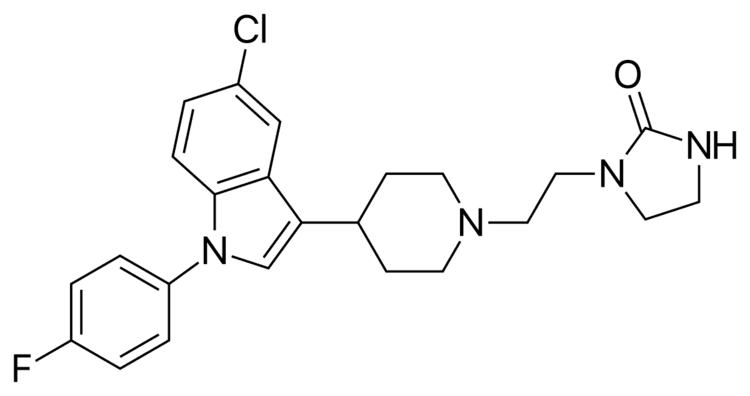Pregnancycategory AU: C ATC code N05AE03 (WHO) CAS ID 106516-24-9 Protein binding 99.5% | Routes ofadministration Oral Molar mass 440.941 g/mol Bioavailability 75% | |
 | ||
AHFS/Drugs.com International Drug Names Legal status AU: S4 (Prescription only)Approved for marketing in approximately 20 countries Metabolism | ||
Sertindole (brand names: Serdolect and Serlect) is an antipsychotic medication. Sertindole was developed by the Danish pharmaceutical company Lundbeck and marketed under license by Abbott Labs. Like other atypical antipsychotics, it has activity at dopamine and serotonin receptors in the brain. It is used in the treatment of schizophrenia. It is classified chemically as a phenylindole derivative.
Contents
Sertindole is not approved for use in the United States and was discontinued in Australia in January 2014.
Medical Uses
Sertindole appears effective as an antipsychotic in schizophrenia. It may have a favorable side effect profile, and efficacy similar to risperidone.
Adverse effects
Very common (>10% incidence) adverse effects include:
Common (1–10% incidence) adverse effects include:
Uncommon (0.1–1% incidence) adverse effects include:
Rare (<0.1% incidence) adverse effects include:
Unknown frequency adverse events include:
Pharmacology
Sertindole is metabolized in the body to dehydrosertindole.
USA
Abbott Labs first applied for U.S. Food and Drug Administration (FDA) approval for sertindole in 1996, but withdrew this application in 1998 following concerns over the increased risk of sudden death from QTc prolongation. In a trial of 2000 patients on taking sertindole, 27 patients died unexpectedly, including 13 sudden deaths. Lundbeck cites the results of the Sertindole Cohort Prospective (SCoP) study of 10,000 patients to support its claim that although sertindole does increase the QTc interval, this is not associated with increased rates of cardiac arrhythmias, and that patients on sertindole had the same overall mortality rate as those on risperidone. Nevertheless, in April 2009 an FDA advisory panel voted 13-0 that sertindole was effective in the treatment of schizophrenia but 12-1 that it had not been shown to be acceptably safe. As of October 2010, the drug has not been approved by the FDA for use in the USA.
Europe
In Europe, sertindole was approved and marketed in 19 countries from 1996, but its marketing authorization was suspended by the European Medicines Agency in 1998 and the drug was withdrawn from the market. In 2002, based on new data, the EMA's CHMP suggested that Sertindole could be reintroduced for restricted use in clinical trials, with strong safeguards including extensive contraindications and warnings for patients at risk of cardiac dysrhythmias, a recommended reduction in maximum dose from 24 mg to 20 mg in all but exceptional cases, and extensive ECG monitoring requirement before and during treatment.
